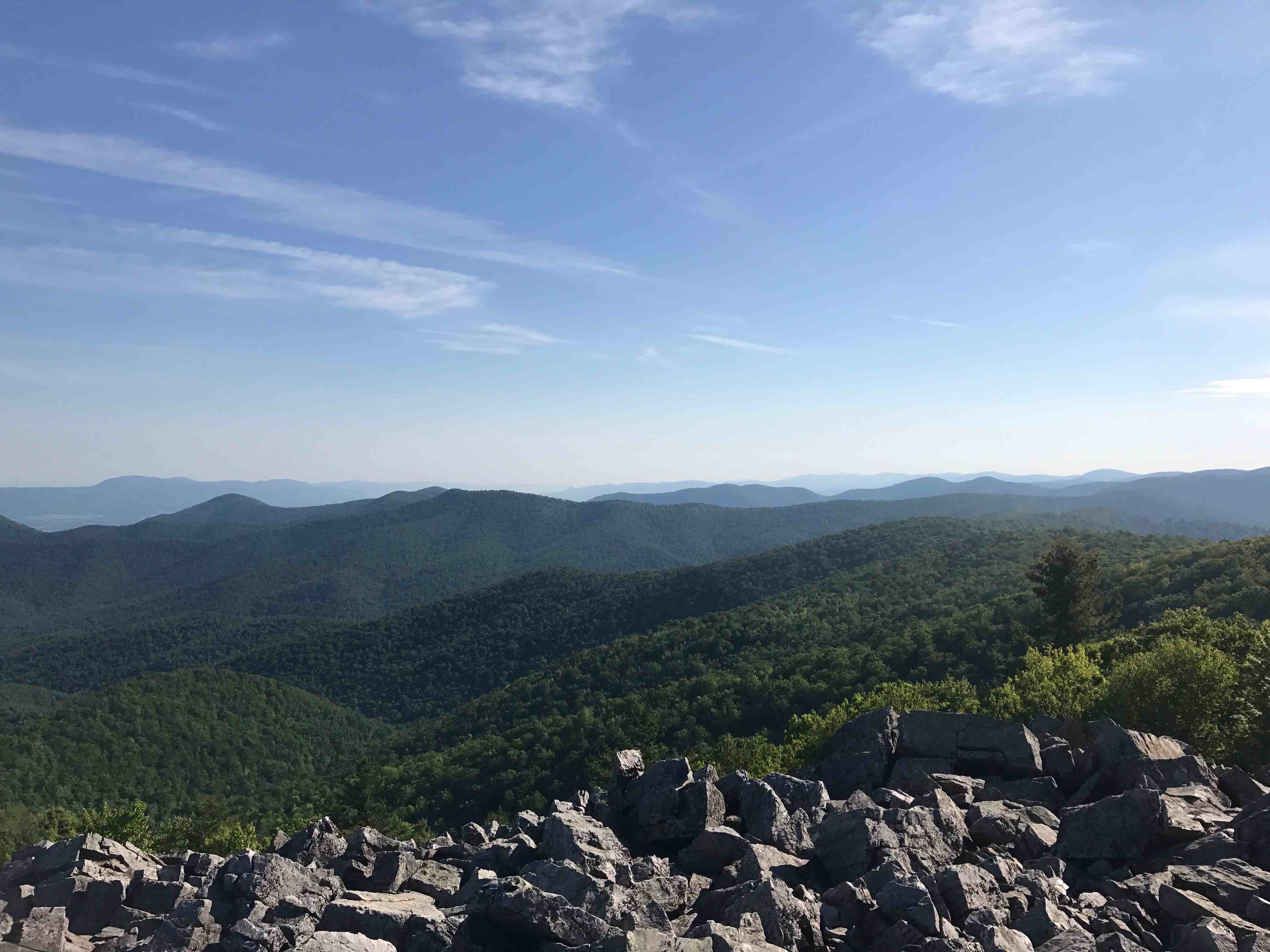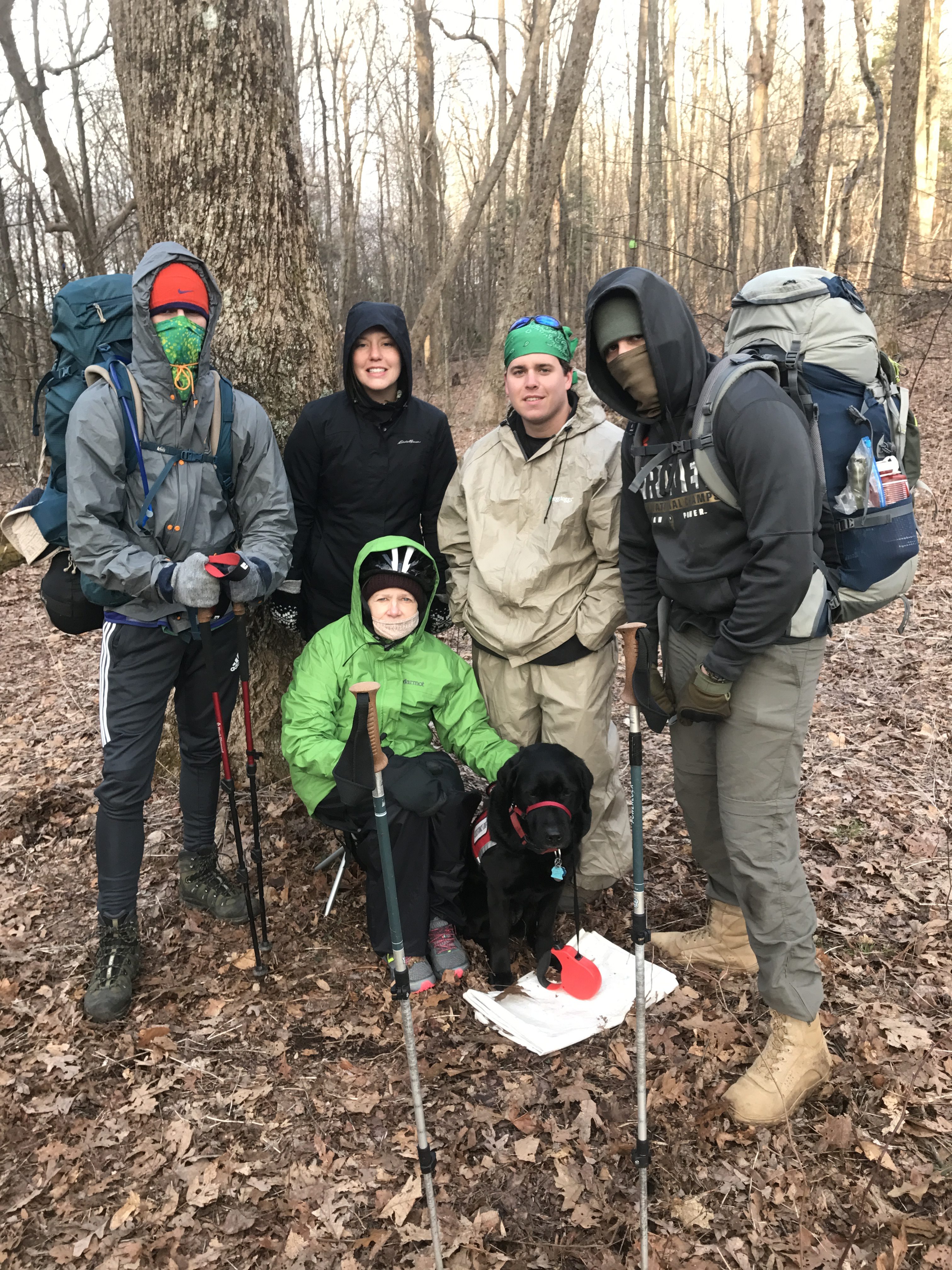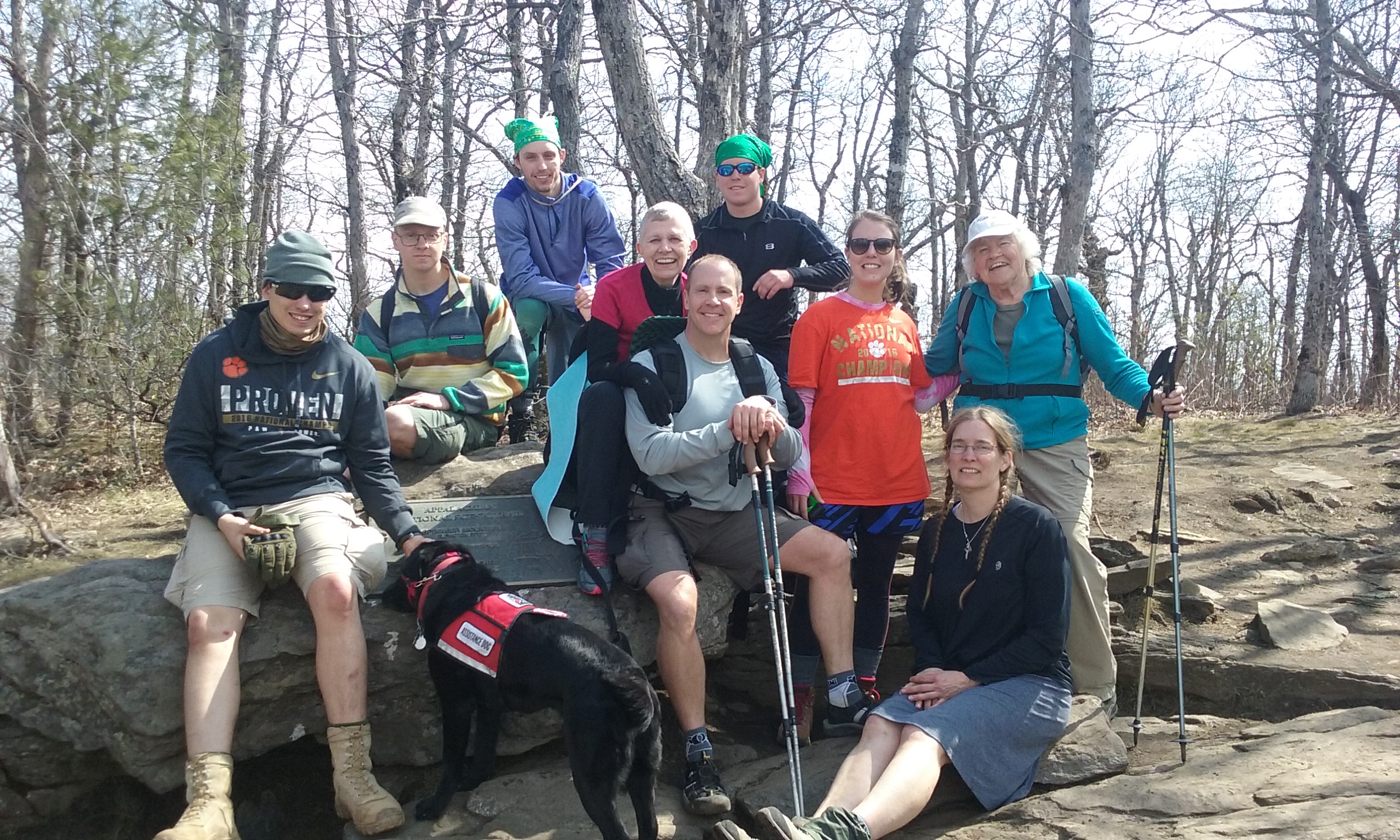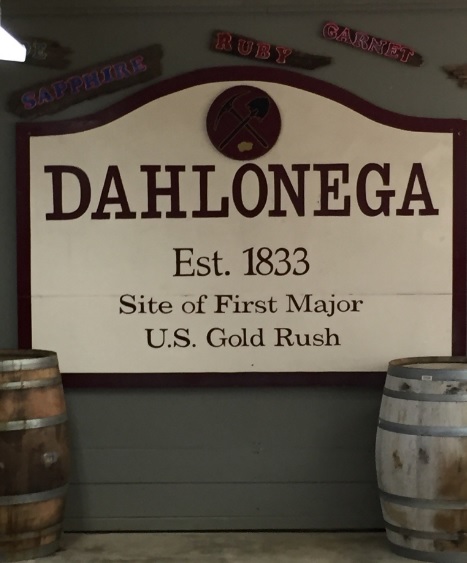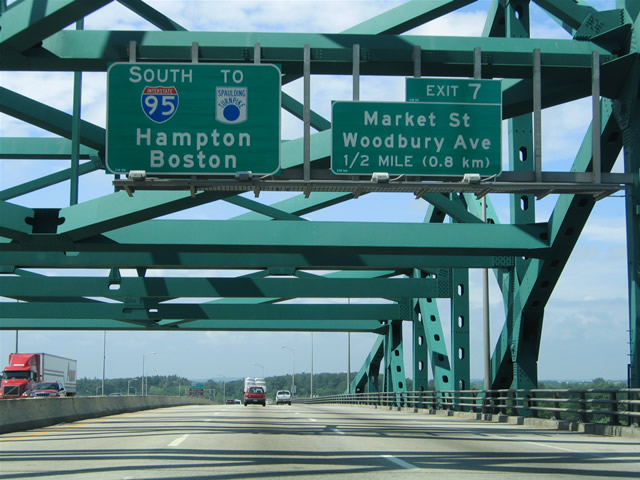After Heidi left us we did more hiking. We were coming to a trailhead to meet Honey and Bear and get some supplies. We also heard that there was some trail magic—a place that was offering a hiker feed. An older man, Jeremiah, and his younger male companion came up looking for us. Honey had told them about us. Jeremiah wanted to try carrying for a while. I was concerned about him. Jeremiah is not a young man and was quite heavyset. I was concerned about the strain that this was putting on him. He made it for about seven minutes, which was remarkable. Then we asked the young man, Justin, if he wanted to try. He hadn’t really thought about it, but stepped up and did well. Their rotations really helped out the Clemson Crew.
When we got to the trailhead, it was time for a break. Jeremiah is part of a group that has some hiker hostels along the trail. Here they had taken a double-decker bus and fixed it into a hostel. Everyone went over to check it out. I stayed put on the tailgate, grateful for the break. The rest of the gang had something to eat and drink, including an unusual tea. They also met some more of Jeremiah’s group, including his wife. His wife came over to meet Saint and me. She had a connection to Maine, so wanted to make herself known.
The crew was tired and there was a ways to go to get to a good camping area. So, again, we thought that we should get a ride for a mile or two. But in this area, the road was paved and had a speed limit, so sitting on the tailgate would not be an option. We thought that we would need to travel in two groups, with one going ahead to wait until the next one could come along. But, as always, we were lucky. There was a woman there who knew Honey and Bear—she had stayed with them some years back. (Honey and Bear are always meeting people whom they have helped along the way.) She offered to take some of our group to our next jumping off place. She was doing this with her own car, just to be helpful, and wanted nothing in return.
We got a ride to Neels Gap. Some of our group checked out the supplier or used the privies. Then we hiked to our camping spot for the night: Bull Gap. We got there with plenty of daylight to spare. This was fortunate, because it gave time to set up camp and send people on a rather long walk for water. It also may have been here that the line for our (Hopper, Saint and my) bear bag got tangled and broke. So from thereon, we used the Clemson Crew’s bear-bag line.
Bears are an issue along the AT. They can be attracted by anything with a scent. So one hangs one’s food and toiletries and cook pot in a bag suspended on a line from a tree limb high enough and far enough out that bears can’t reach it. There are some parts of the trail where bear canisters mandatory. Many hikers try to avoid these sections and also think that they are capricious—do the bears know where the regulations start and stop? :>) The bears are lured by easy food. But this harms everyone, especially the bears. Bears that eat trash don’t live as long. If they become aggressive, they may need to be killed. So there are people whose summer job is chasing bears, trying to re-instill fear of people into them. They may make loud noises at bears, bark at them, may even shoot bean bags at them. We never saw any bears during our stretch of hiking. And Saint would be a good deterrent for me. But we didn’t want to tempt the bears and make things more difficult for them, either.
By the third night, the hike was taking a toll on the kids, in particular. Some were getting serious blisters. They were consuming ibuprofen. But they remained game. We sat around a campfire that night with others whom we had not known. People were interested in what we were doing. One of my favorite moments from that experience came when a young man said, “That’s so great. I hope that when I’m really, really old, someone will carry me.” I’m not sure if he thought that that was what would make him unable to hike. Or if he thought of me as really, really old. Regardless, I did laugh inside. One doesn’t get a big ego on the AT.
Along the way, the four Clemson students acquired some trail names. When we had started, Hopper asked them if they wanted to pick a trail name or just let it happen. They decided to let it happen. Jimmy became “Gold Member.” That came about because he split his pants early on from the crotch all the way up the back. He tried to repair them with duct tape and all that we had available was gold. Brad had several names. Most of the Clemson called him Triple B. His name is Frederick Bradford Bradley. Sean mistakenly thought that his first name also started with a B, so called him Triple B and it stuck. I called him BOS—Buns of Steel. That’s because early on he said that the muscles in his buttocks were on fire. All the kids learned how useful Tiger Balm can be. Lindsay was the only girl and has a high-pitched voice. So she became Screech. Philip also had a variety of trail names. The one that seemed to stick the most was Philbo, at takeoff on Bilbo from Lord of the Rings. I had told the kids early on that I identify strongly with Frodo—a small person leaving behind his beloved county and off on a great adventure. So Philbo seemed particularly apt.
To pass the time as we went along, we would tell stories. I told the students many stories from my life and also about Saint. They said that my voice was soothing and kept them calm and upbeat. I wound up telling the same stories many times because some of them would be out of range and I would need to catch people up. I also tried to learn about the kids and their stories. This was more challenging, because they would be already exerting hard by carrying and could get out of breath. I did manage to learn a bit, though.
Jimmy is a self-made man. He hadn’t really thought much about going to college. He joined ROTC in high school and it changed his life. So as he got near graduating, he began to consider going to college: ROTC would pay his way. Jimmy is a business/human resources major and a junior and 21. He wants to become an officer in the reserves and go into HR to help people. He credits ROTC with helping develop his character. He also does some work with athletics, helping out at games.
Philip was the youngest. When we hiked, he was 19, although he turned 20 a week later. As the youngest and the shortest male, he was an object of good-natured teasing. He was also often the quietest. He has a sweet temperament and a huge heart. He is majoring in mechanical engineering. The others teased him that he was just going to be a fancy mechanic. He also did not know a popular meme based on Dr. Phil—“Meet me outside—how bou tha”–much to the delight of the others. But he stepped up big time when needed.
Lindsay was also a junior and a nutrition major. She is one gutsy lady. She joked and said that being with the guys was like hanging out in a locker room. She probably had the least outdoor experience of anyone. Sean took her for a hike one weekend day before our trip to see how she would do. He gave her a heavy pack to carry and reported that she did fine but that she never stopped talking. She is a chatterbox, but it helps pass the time. Her parents were concerned about her going on the trip, but she decided to do it anyway. She took her turn in the rotation and a few times even exceeded 10 minutes. Lindsay has a heart of gold and is a great believer in true love. When Hopper shared some of her background, Lindsay said that she was the most interesting person that Lindsay had ever known. But we countered that, really, everyone is interesting. Lindsay just got a chance to know more about Hopper. On the trail, people will share the most personal stories to help pass the time. A lot of the façade of civilization gets stripped off on the trail.
Brad was the oldest of the four: 24. He was working on his second bachelor’s degree. His first was in chemistry. This one is bio-chemistry. He was going for a second because he said that he had too much fun the first time around. At one time he had worked in an emergency room and seen quite a slice of life. That influenced him to want to become an ER doctor. He had two older sisters (twins?) who had also attended Clemson. He shared an apartment with one of his sisters in Clemson. Brad was largely putting himself through school. He worked full time for a men’s clothing store. Brad was the fashion plate of the group. He had many, many suits, sports coats, slacks. I was entertained one day listening to Brad give Philip clothing advice. He was talking about his ostrich leather shoes, among other things. He talked about hanging a suit jacket on a cedar hanger to absorb perspiration and help it keep its shape. He explained quality belts and how one should never wear black with brown. When Hopper talked about how few clothes she had, Brad said that that kind of made him question his wardrobe. But that did not last. He got discounts on the clothes and was built like a model: tall and slim. He was about 6’2” and weighed around 140 pounds. He liked to dress up and stand out.
I also learned about men’s jewelry from Brad. Clemson is very big on school rings. One can get them in various metals. Brad had one and the other students expected to get one as well. Brad had a mid-range ring that cost $1,000. Students get their rings in a ring ceremony. That’s when Brad got his first suit. He liked cuff links with shirts. And a wealthy, childless uncle had given him a vintage, refurbished Rolex watch. He didn’t have these things on the trip but wore them afterward when we saw him.
Brad had been quite a baseball player in high school. He and his dad had thought that Brad might make it in the pros. He was a pitcher with a very fast ball. But he tore up his shoulders so that dream did not come to pass.
Perhaps because he was a little older, Brad seemed to be the most immediately reflective about the trip and his transformation through it.
By our fourth day, Thursday March 23, our little bad was hurting. Hopper’s knee was very swollen. She has arthritis in that knee and will probably need to have it replaced. Sean seemed in the best shape—at least he wasn’t sharing his pain. Lindsay was rolling her ankles. Brad’s shoulders, never in good shape, were painful. But his feet were more problematic. He had a split toenail, nasty blisters and an angry blood blister. We tried emergency foot care, including using duct tape. But things were tough. One of the biggest problems was that we weren’t moving fast enough to get to more water. There wasn’t a trailhead to which Honey and Bear could take us that would get us close enough that we could reliably make it. No one wanted to stop. But we couldn’t go on without water. And we didn’t want anyone to get hurt. So we reluctantly decided to get off the trail that afternoon. The kids were relieved but also sad. Jimmy seemed to take it hardest, apologizing for letting me down. I needed more time with the kids and a chance to explain that no way did these folks let me down.
Our next blog will be about camping with the kids back in Dahlonega and then finding our way to and a place to stay in Clemson, SC. Until then, take care. Be well.
Dr. J.


